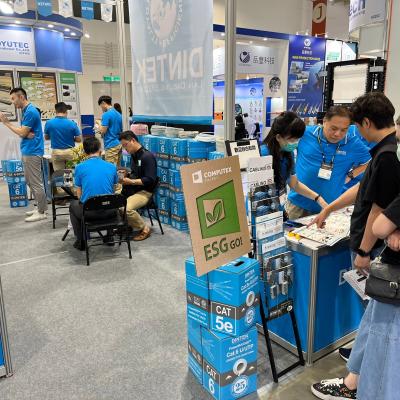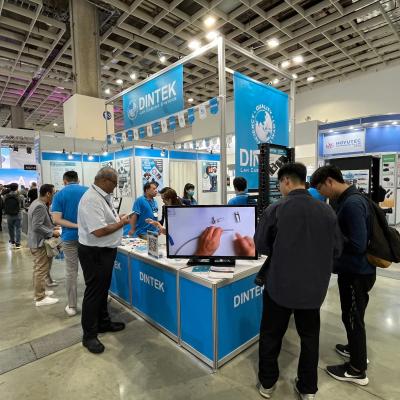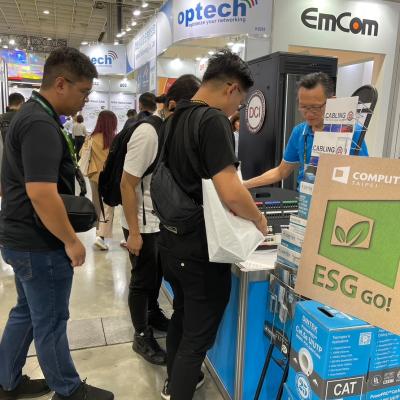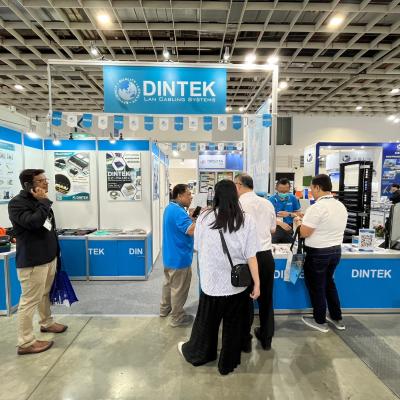A guide to structured cabling
Technology and telecommunication are essential to almost every business, regardless of their size or industry. An essential component of a company's network is its cabling infrastructure, which binds everything together & dictates the speed at which it runs.
Often, network administrators hear that their network is down because of cables, with studies suggesting that up to 70 percent of network issues are a result of low-quality cabling systems. When the cabling infrastructure is inadequate, performance is lower, maintenance is increased, the network is unreliable, and productivity is low. And considering cable systems have an average lifespan of only 10 years, it's essential to deploy cable systems accurately and with reliable networking equipment at the beginning.
The solution? Installing a Structured Cabling System will you help to stay ahead of all the technological developments, so that you have the right infrastructure in place to support new and latest technologies as they emerge.
What is a structured cabling system?
Rather than a jumble of tangled wires (which is all too common!), a Structured Cabling System is organized and neat and follows the regulations and standards for commercial cabling, ensuring greater safety, security, efficiency, and future-proofing. As the name suggests, this 'structured' approach to cabling offers a single-mixed media network system that controls all data traffic such as voice, data, and video.
Structured cabling can be broken down into a few components, the most basic being cables, switches, patch panels and trunk cables which can all then be grouped into a sub-system. There are six sub-systems that make up a complete structured cabling network:
Entrance facilities: An entrance facility, in a structured cabling system, is the physical point where the premise's wiring begins and the telephone company or internet provider's wiring ends. In other words, this is the point at which the facility or premise company is now responsible for the cabling.
Equipment room: Equipment rooms are any rooms on the premises that house any equipment or consolidation points for the system. This will be where you usually find switches and routers for structured cabling.
Telecommunications room: A telecommunications room houses the termination points for your system's backbone cabling and horizontal cabling, including fiber jumpers or patch cords.
Backbone cabling: Backbone cabling is made up of the actual cables that run throughout the system. It can either be cabling between horizontal cross-connects and intermediate cross-connects or the cabling between the intermediate cross-connect and the main cross-connect.
Horizontal cabling: Horizontal cabling in a structured cabling system connects the telecommunications room to outlets or the work areas on the premises. It is usually the cabling and data drops that run to the computers in the office.
Work area: The work area is where an end-user's equipment is. This will then hook up equipment such as computers, hosted phones, or any Wi-Fi enabled devices that plug into a wall outlet are in the work area.
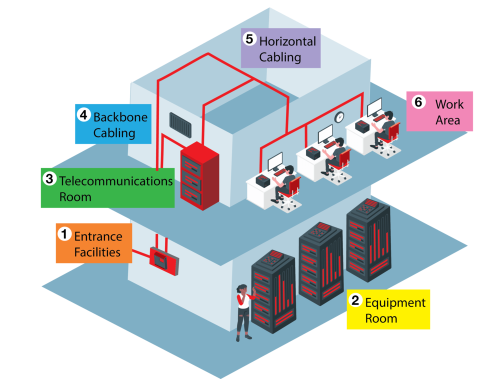
Why is a structured cabling system important?
A well-designed & perfectly installed structure cabling system technology provides such a cabling infrastructure that delivers magnificent performance and gives you the extra flexibility to accommodate moves, additions, & changes; maximizes your system availability; and future proofs the usability of the cabling system.
Cost effective
Having a fully engineered and properly installed structured cabling system technology is one of the most cost-effective and timely decisions you can make for your business. It'll make routine moves, adds & changes faster, much more efficient and has tangible & intangible advantages.
The enhancement in productivity, faster rollout of strategic company applications and more efficient troubleshooting features and capabilities will help any business to be more successful.
Adaptability and growth
Structured cabling systems technology is built with adaptability and extreme growth in mind. Generally, these kinds of systems can support very high and accurate bandwidth. Being able to continuously upgrade your telecommunication system needs without an overhaul of your current cabling technology saves your company so much time & money. Additionally, when your business outgrows your current building, transferring your cabling system technology and reinstalling your network infrastructure is much more approachable than relocating a complex, old cabling system.
Less downtime
Unorganized cabling systems make it hard to identify & resolve errors. Also, disorderly cabling systems are most likely to cause confusion & mistakes in the initial setup process. When a situation occurs, & your telephone lines go down, troubleshooting your proper hardware takes more of your time if the staff needs to sort through a jumble of networking cables. Your voice & data cabling systems are more effective and reliable when the infrastructure accommodates faster and effortless repairs.
Well organized
Structured cabling systems are extremely organized, effortless to use, and are the most effective methods to be implemented in your workspace. A structured cabling system is simple to manage and maintain and is also an initial one-time investment that profits your company for years to come.
Supports multiple systems and applications
Fiber-structured cabling works in conjunction with other systems and applications to make an ideal business environment. Many businesses today have their operations centered in several locations, and holding business meetings in such types of settings is a bit complicated.
The complexity brought about by different locations can be easily simplified by adopting a structured cabling system in your business. This system gives you the VoIP software, which can be used to hold business meetings remotely.
Apart from the famous VoIP software, structured cabling systems support security camera systems. With the surveillance cabling system in place, you'll be in a position to monitor the variety of activities of your company from any location.
An investment for the future
While common cabling systems are mostly directed to current business operations, fiber-structured cabling systems have an eye on the future. This trait makes the fiber-structured cabling system one of a kind. Also, the system has a high bandwidth which makes this system more convenient for supporting the growth of your company.
Retaining old clients and then continuously acquiring new ones is a great concern for every organization. Investing in a structured cabling system for data & voice gives room for instant & continued communication with all consumers. With the prospect of winning new clients and customers in place, a structured cabling system is indeed a project for the future.
What are the regulations and standards for structured cabling?
Over the years, cabling has undergone a lot of changes. It was common for cabling systems to be proprietary, vendor-specific, and less flexible until the early 1990s, but as cabling installations have evolved, proprietary systems have given way to flexible, open solutions that can be used by a variety of vendors and applications. A standard-based, structured cabling system has led to this change. As a result of the cooperation between many telecommunications vendors and international standards organizations, this acceptance is not only driven by customers but also by international standards organizations.
- ISO (International Standardization Organization): This is the main international telecommunications systems standards organization.
- IEC (International Electro technical Commission): This is an organization that certifies component parts for electrical performance. Along with the ISO, the IEC developed the ISO/IEC 11801 (Generic cabling for customer premises) standard.
- CENELEC (European Committee for Electro technical Standardization): CENELEC developed the ENS0173 standard used throughout parts of Europe - they basically regionalized the ISO/IEC 11801 standard. AS/NZS (Australian/New Zealand Standard):
- AS/NZS developed a similar standard, called the AZ/NZS 3080. CSA (Canadian Standards Association):
- CSA developed the CSA T529, a similar standard to the ISO/IEC 11801, used throughout Canada.
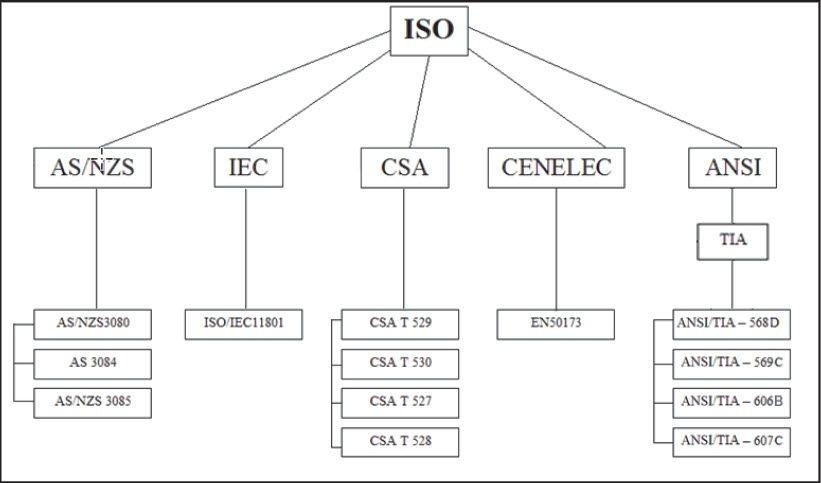
ANSI/TIA-568.D Cabling Standard
ANSI (American National Standards Institute) is an organization that has other organizations and standards bodies reporting to and through it,
including TIA (Telecommunications Industry Association) and EIA (Electronic Industries Association).
The TIA and ANSI have joined forces to develop communications standards for commercial premises, including the ANSI/TIA-568.D, (Commercial Building Telecommunications Cabling Standard).
ISO/IEC 11801 Ed. 2 Standard
The ISO/IEC 11801 is called the Generic Cabling for Customer Premises Standard. Its purpose is to provide a world standard for the design, installation, and administration of commercial building telecommunications systems. All other standards that follow have adapted the ISO/IEC-11801 to their particular regions.
ISO/IEC 11801 Ed. 2 Standard
The ISO/IEC 11801 is called the Generic Cabling for Customer Premises Standard. Its purpose is to provide a world standard for the design, installation, and administration of commercial building telecommunications systems. All other standards that follow have adapted the ISO/IEC-11801 to their particular regions.
Why is certification and obtaining a 25yr warranty important?
Reliable network infrastructure is directly responsible for productivity, service efficiency, and expanded services in modern corporations. Every network's copper and fiber telecommunications wiring is a critical component that should not be left untested.
Certification is the most thorough testing for network cabling, ensuring that a cabling system meets rigorous performance and installation standards. By certifying the cable network, failures can be reduced. Some benefits include:
- Keeps out substandard materials and workmanship
- Cable certification is less expensive than repair
- Cable certification and recertification future-proof the infrastructure
- Uncertified cabling = stranded capital
- Reducing waste is good policy
A certified cable is far more valuable than an uncertified cable. We always want to get the most value out of our investments. Looking at copper and fiber cabling plants, one of the best ways to gain more value is to ensure it comes with a long-term replacement warranty directly from the cable manufacturer. Obtaining a full manufacturer's warranty can only be accomplished through cable certification testing. Without proving passing certification test results, your cabling will not be fully covered by most manufacturer warranties.
Acquiring a fully certified manufacturer's warranty should be thought of as an insurance policy against future outages caused by any physical-cabling defect. Once a cable plant is put into production, even a short outage lasting a few minutes can significantly impact an organization from an operational and profitability point of view. Depending on the type and duration of the outage, it can cost a company hundreds to thousands of dollars in lost revenue. The piece of mind to be running fully warrantied copper and fiber is an added layer of protection against outages that may crop up due to poorly made or installed cabling.
Certifying and fully warrantying copper and fiber is not only beneficial to the end customer – it's beneficial to the cable installation contractor as well. The contractor is no longer obligated to back the quality of the cabling themselves. Instead, having a manufacturer-backed warranty removes any risk the installing contractor may have in terms of physical defects to the cabling that may be discovered down the road. Thus, if any faults in the cabling were to be identified in the future, it is replaced at the manufacturer's expense. In the end, both the end customer and the structured cabling contractor benefit. That's why proper certification testing to achieve a full warranty is so important.
DINTEK's 25 Year Warranty
DINTEK's 25-year warranty will provide the recipient with the security and assurance of knowing that their installed DINTEK cabling system will provide the performance and stability they need to meet their long-term networking needs. The program offers a 25-year standards-based, system performance, and application assurance warranty, that applies to all certified and registered DINTEK cable links in an installation project.
The program warrants that these links will meet minimum performance requirements as specified in the relevant ANSI/TIA or ISO Commercial Building Telecommunications Cabling Standards.
What is covered?
Standards - the 25-year warranty will certify that the cabling system complies with the latest relevant ISO & ANSI/TIA standards.
Products - the 25-year warranty will certify that DINTEK products covered will be free from any defects.
Installation - the 25-year warranty will certify that the cabling system has been installed by qualified DINTEK installers.
Performance - the 25-year warranty will certify that the cabling system will perform for at least 25 years.

Click here for more information on DINTEK's 25-year warranty
DINTEK offers a comprehensive range of high-quality cabling products perfect for your structured cabling needs!


